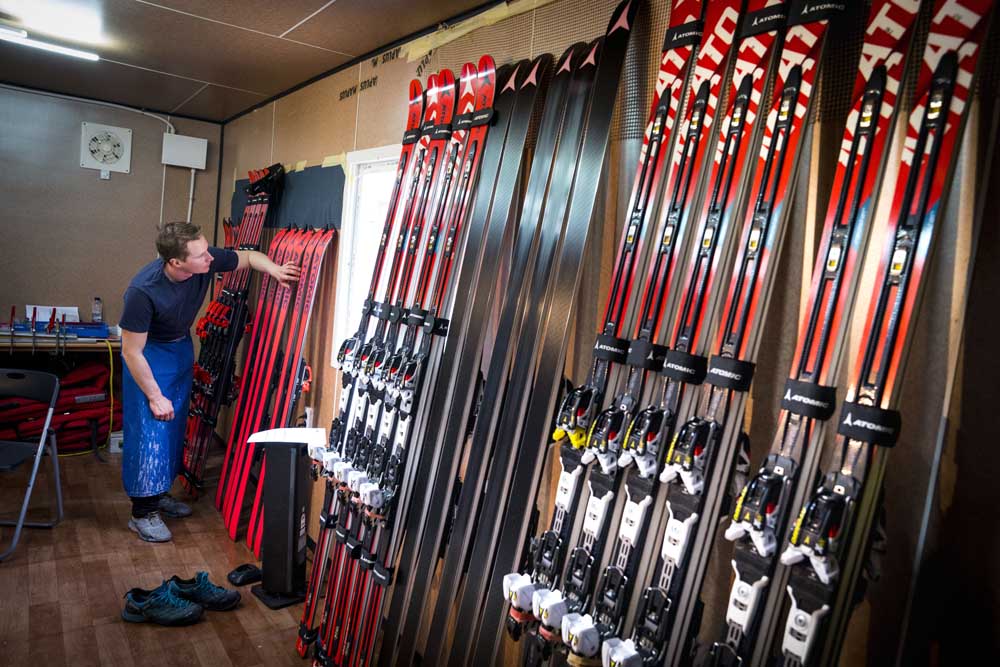For versatile Shiffrin, packing light simplyis not an option
Published 12:00 am Thursday, February 22, 2018

- Mikaela Shiffrin’s ski technician, Kim Erlandsson, tends to Shiffrin’s hefty collection of skis in Pyeongchang, South Korea, on Monday. Shiffrin, a two-time Olympic champion, often travels with as many as 70 pairs, each suited to a different discipline or snow condition. (Doug Mills/The New York Times)
PYEONGCHANG, South Korea — Mikaela Shiffrin uses only one pair of skis for an Olympic race. But just in case, she has 35 pairs with her here at the Winter Games — and, for her, that is a relatively light load.
She often travels to competitions with 70 pairs of skis. It is a herculean task to lug so many long, pointed, sharp-edged skis across three continents during the six-month racing season. Forgive the airline baggage clerks if they groan when Shiffrin shows up with a cargo van jampacked with items to check.
“That can take a long time,” said Kim Erlandsson, the 29-year-old ski technician who is responsible for transporting Shiffrin’s precious gear. “Get there early.”
Unlike most racers, who ski in only two or three events, Shiffrin needs so many skis because she regularly competes in each of the five alpine events. (Because of weather-related scheduling changes, she is skiing in only three events at these Olympics.)
The races are wholly dissimilar, with varying distances, turning requirements and speeds. Each requires specifically designed skis.
Shiffrin’s slalom skis, for example, are 155 centimeters long (slightly more than 5 feet) and have an hourglass shape, while her downhill skis are almost as straight as a floorboard and might be as long as 225 centimeters (nearly 71⁄2 feet). Within each race category, a range of skis could be needed, as many as 25 per race. Slalom skis account for about one-third of Shiffrin’s quiver.
“It’s a load to handle,” Shiffrin said. “But completely necessary.”
Shiffrin, a two-time Olympic champion who on Thursday won silver in the alpine combined, may never need all 70 pairs of her Atomic-brand skis; it depends on the fickle winter weather and the vicissitudes of the roughly 20 mountains where she races each season. But she has skied on and carefully analyzed each of those 70 pairs. She needs to know exactly how the skis will perform in each circumstance, and most important, if she can rely on them at daredevil speeds.
After trying each pair, she gives Erlandsson a detailed report — assessing their strengths in certain conditions, like icy surfaces, moderate or subzero temperatures, bumpy slopes or when she has blasted down the mountain at 80 mph.
Erlandsson catalogs those findings in a little black book that is Shiffrin’s equipment bible. “I have a lot of pages,” he said Monday.
All elite racers travel with dozens of skis on the World Cup tour, usually 25 to 40 pairs. Each pair has a different length, or wax preparation, or engineering, or material composition, or the placement of the binding, which is how a skier’s boots are affixed to the ski. Since most races are decided by tenths, if not hundredths, of a second, the choice of skis — an intricate calculation that depends on terrain, temperature and weather — can be the difference between a winning run and a forgettable one.
For the Pyeongchang Olympics, Shiffrin scaled back her supply to 35 pairs of skis. By this point, at the end of the season, she has whittled it down through trial and error to her favorite pairs.
Still, throughout these games, Shiffrin has been in daily contact with Erlandsson to talk about her equipment. They deliberate over the choices and the modifications to be made before each training session and race. Last week, between the morning and afternoon runs of the Olympic giant slalom, Shiffrin visited with Erlandsson again.
What did they discuss? “Adjustments,” Erlandsson, a man of few words, answered.
In her second run, Shiffrin came from behind to win the gold medal.






